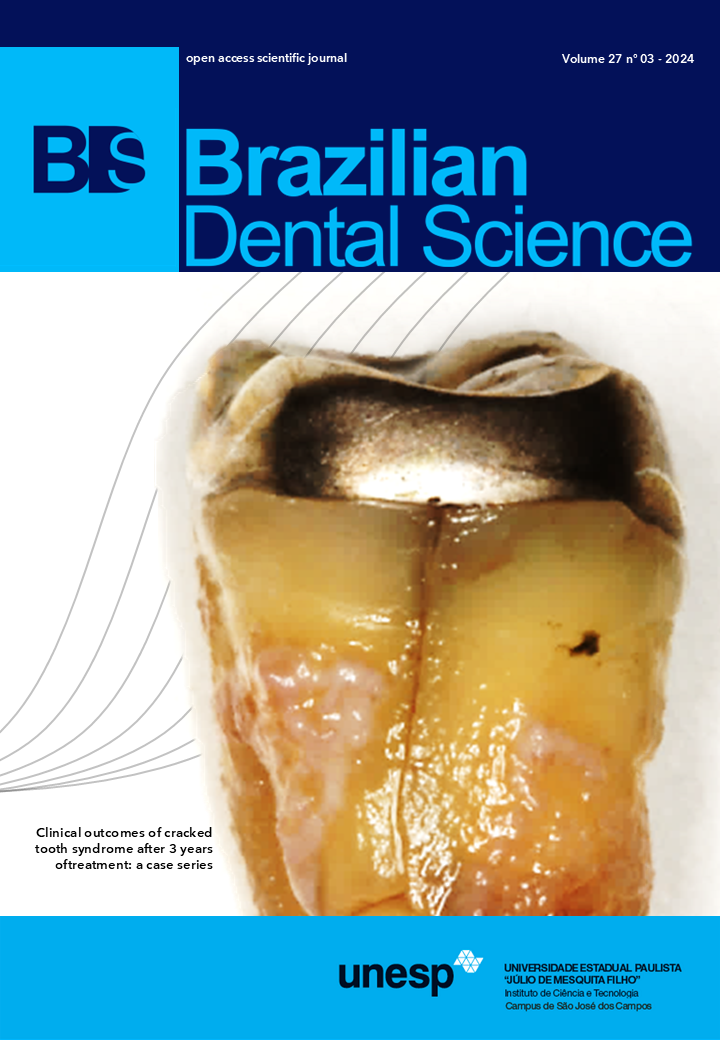Role of antimicrobial peptide on cariogenic biofilm and dental enamel demineralization
DOI:
https://doi.org/10.4322/bds.2024.e4263Resumo
Objective: To investigate the effect of antimicrobial peptide (AMP) D1-23 on antibiofilm activity and enamel demineralization by using a microcosm biofilm model. Material and Methods: Human saliva biofilm was grown on bovine enamel discs, which were divided into 4 groups according to the 24-hour growth treatment: 0.2 mM AMP D1-23; 1 mM AMP D1-23; Defined Medium with Mucin (DMM; negative control); and 2% chlorhexidine (CHX; positive control). The biomass and number of cultivable cells of a 4-day-old biofilm were evaluated for antibiofilm activity. For analysis of enamel mineral loss by the 7-day-old biofilm and investigated treatments, the Knoop surface microhardness method was performed. ANOVA and Tukey tests were used to analyze data from biomass and enamel surface microhardness. Culturable cells data were analyzed by a pairwise Kruskal-Wallis test. A significance level of 5% was considered for all tests. Results: Although the two concentrations of AMP D1-23 had similar effects on the amount of biofilm biomass (p>0.05), a reduction in biomass was observed when compared to the control group (p < 0.05). The antimicrobial activity of 1 mM AMP D1-23 was similar to that of 2% CHX against Streptococcus mutans, whereas against Streptococci sp and Candida sp it was lower (p <0.05). Also, the 1 mM AMP D1-23 significantly reduced enamel demineralization (p < 0.05). Conclusion: Under the limitations of this study, the 1 mM AMP D1-23 appears to have positive effect on controlling dental enamel demineralization and may be considered a potential treatment for non-cavitated carious lesions.
KEYWORDS
Antimicrobial cationic peptides; Dental caries, Dental plaque; Public health; Tooth remineralization.
Downloads
Downloads
Publicado
Como Citar
Edição
Seção
Licença
TRANSFERÊNCIA DE DIREITOS AUTORAIS E DECLARAÇÃO DE RESPONSABILIDADE
Toda a propriedade de direitos autorais do artigo "____________________________________________________________________" é transferido do autor(es) para a CIÊNCIA ODONTOLÓGICA BRASILEIRA, no caso do trabalho ser publicado. O artigo não foi publicado em outro lugar e não foi submetido simultaneamente para publicação em outra revista.
Vimos por meio deste, atestar que trabalho é original e não apresenta dados manipulados, fraude ou plágio. Fizemos contribuição científica significativa para o estudo e estamos cientes dos dados apresentados e de acordo com a versão final do artigo. Assumimos total responsabilidade pelos aspectos éticos do estudo.
Este texto deve ser impresso e assinado por todos os autores. A versão digitalizada deverá ser apresentada como arquivo suplementar durante o processo de submissão.




























